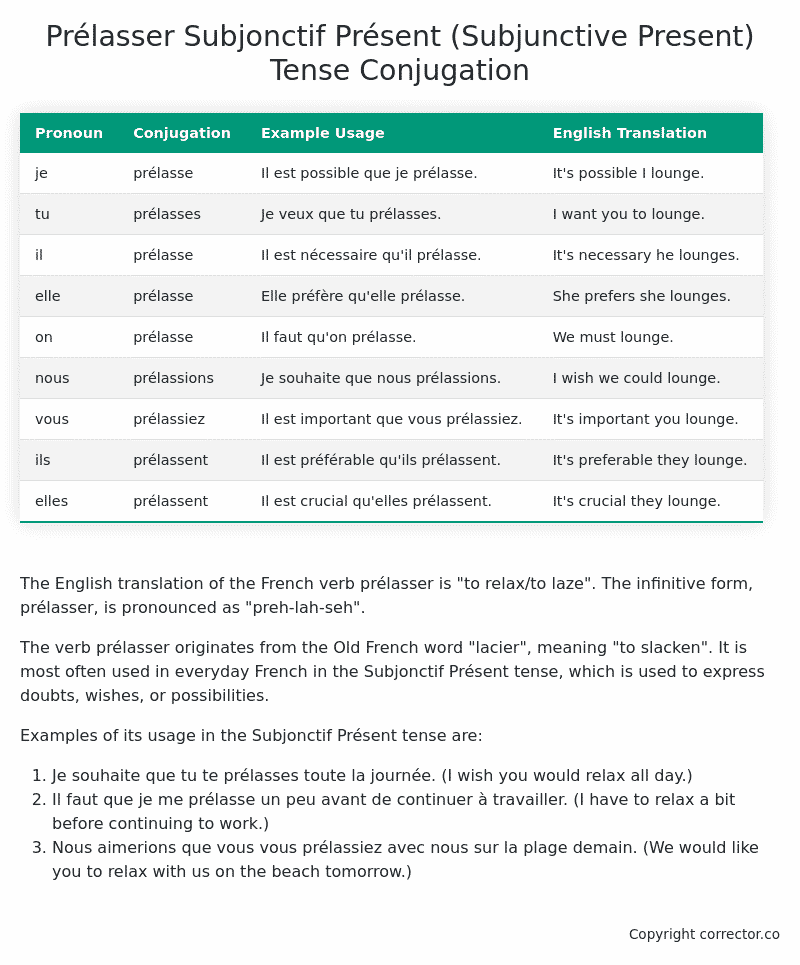Subjonctif Présent (Subjunctive Present) Tense Conjugation of the French Verb prélasser
Introduction to the verb prélasser
The English translation of the French verb prélasser is “to relax/to laze”. The infinitive form, prélasser, is pronounced as “preh-lah-seh”.
The verb prélasser originates from the Old French word “lacier”, meaning “to slacken”. It is most often used in everyday French in the Subjonctif Présent tense, which is used to express doubts, wishes, or possibilities.
Examples of its usage in the Subjonctif Présent tense are:
- Je souhaite que tu te prélasses toute la journée. (I wish you would relax all day.)
- Il faut que je me prélasse un peu avant de continuer à travailler. (I have to relax a bit before continuing to work.)
- Nous aimerions que vous vous prélassiez avec nous sur la plage demain. (We would like you to relax with us on the beach tomorrow.)
Table of the Subjonctif Présent (Subjunctive Present) Tense Conjugation of prélasser
| Pronoun | Conjugation | Example Usage | English Translation |
|---|---|---|---|
| je | prélasse | Il est possible que je prélasse. | It’s possible I lounge. |
| tu | prélasses | Je veux que tu prélasses. | I want you to lounge. |
| il | prélasse | Il est nécessaire qu’il prélasse. | It’s necessary he lounges. |
| elle | prélasse | Elle préfère qu’elle prélasse. | She prefers she lounges. |
| on | prélasse | Il faut qu’on prélasse. | We must lounge. |
| nous | prélassions | Je souhaite que nous prélassions. | I wish we could lounge. |
| vous | prélassiez | Il est important que vous prélassiez. | It’s important you lounge. |
| ils | prélassent | Il est préférable qu’ils prélassent. | It’s preferable they lounge. |
| elles | prélassent | Il est crucial qu’elles prélassent. | It’s crucial they lounge. |
Other Conjugations for Prélasser.
Le Present (Present Tense) Conjugation of the French Verb prélasser
Imparfait (Imperfect) Tense Conjugation of the French Verb prélasser
Passé Simple (Simple Past) Tense Conjugation of the French Verb prélasser
Passé Composé (Present Perfect) Tense Conjugation of the French Verb prélasser
Futur Simple (Simple Future) Tense Conjugation of the French Verb prélasser
Futur Proche (Near Future) Tense Conjugation of the French Verb prélasser
Plus-que-parfait (Pluperfect) Tense Conjugation of the French Verb prélasser
Passé Antérieur (Past Anterior) Tense Conjugation of the French Verb prélasser
Futur Antérieur (Future Anterior) Tense Conjugation of the French Verb prélasser
Subjonctif Présent (Subjunctive Present) Tense Conjugation of the French Verb prélasser (this article)
Subjonctif Passé (Subjunctive Past) Tense Conjugation of the French Verb prélasser
Subjonctif Imparfait (Subjunctive Imperfect) Tense Conjugation of the French Verb prélasser
Subjonctif Plus-que-parfait (Subjunctive Pluperfect) Tense Conjugation of the French Verb prélasser
Conditionnel Présent (Conditional Present) Tense Conjugation of the French Verb prélasser
Conditionnel Passé (Conditional Past) Tense Conjugation of the French Verb prélasser
L’impératif Présent (Imperative Present) Tense Conjugation of the French Verb prélasser
L’infinitif Présent (Infinitive Present) Tense Conjugation of the French Verb prélasser
Struggling with French verbs or the language in general? Why not use our free French Grammar Checker – no registration required!
Get a FREE Download Study Sheet of this Conjugation 🔥
Simply right click the image below, click “save image” and get your free reference for the prélasser Subjonctif Présent tense conjugation!

Prélasser – About the French Subjonctif Présent (Subjunctive Present) Tense
Formation of the Subjonctif Présent
Common Everyday Usage Patterns
Interactions with Other Tenses
Summary
I hope you enjoyed this article on the verb prélasser. Still in a learning mood? Check out another TOTALLY random French verb conjugation!


